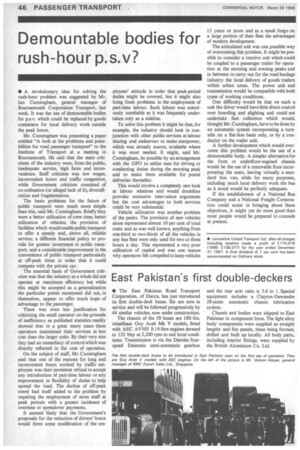Demountable bodies for rush-hour p.s.v?
Page 48

If you've noticed an error in this article please click here to report it so we can fix it.
• A revolutionary idea for solving the rush-hour problem was suggested by Mr. Ian Cunningham, general manager of Bournemouth Corporation Transport, last week. It was the use of demountable bodies for p.s.v. which could be replaced by goods containers for local delivery work outside the peak hours.
Mr. Cunningham was presenting a paper entitled "A look at the problems and possibilities for road passenger transport" to the Institute of Transport at a meeting in Bournemouth. He said that the main criticisms of the industry were, from the public, inadequate service, high fares and inconvenience. Staff criticism was low wages, inconvenient hours and traffic congestion, while Government criticism consisted of co-ordination (or alleged lack of it), diversification and fragmentation.
The basic problems for the future of public transport were much more simple than this, said Mr. Cunningham. Briefly they were a better utilization of crew time; better utilization of vehicles; the provision of facilities which would enable public transport to offer a speedy and, above all, reliable service; a different financial policy to provide for greater investment in public transport; and a considerable improvement in the convenience of public transport particularly at off-peak times in order that it could compete with the private car.
The essential basis of Government criticism was that the industry as a whole did not operate at maximum efficiency but while this might be accepted as a generalization the particular points mentioned did not, in themselves, appear to offer much hope of advantage to the passenger.
There was even less justification for criticizing the small operator on the grounds of inefficiency as published statistics readily showed that in a great many cases these operators maintained their services at less cost than the larger units. By their very size they had an immediacy of control which was directly reflected in the cost of operation.
On the subject of staff, Mr. Cunningham said that one of the reasons for long and inconvenient hours worked by traffic employees was their persistent refusal to accept any introduction of part-time labour or any improvement in flexibility of duties to help spread the load. The decline of off-peak travel had itself added to the problem by requiring the employment of more staff at peak periods with a greater incidence of overtime or spreadover payments.
It seemed likely that the Government's proposals for the reduction of drivers' hours would force some modification of the em
ployees' attitude in order that peak-period duties might be covered, but it might also bring fresh problems in the employment of part-time labour. Such labour was notoriously unreliable as it was frequently undertaken only as a sideline.
To solve this problem it might be that, for example, the industry should look in conjunction with other public services at labour sharing and endeavour to make manpower, which was already scarce, available where it was most needed. It might, said Mr. Cunningham, be possible by an arrangement with the GPO to utilize men for driving or conducting duties during the morning peak and to make them available for postal deliveries thereafter.
This would involve a completely new look at labour relations and would doubtless provoke extensive inter-union arguments but the cost advantages to both services could be very substantial.
Vehicle utilization was another problem of the peaks. The provision of new vehicles alone represented almost 10 per cent of total costs and as was well known, anything from one-third to two-thirds of all the vehicles in any bus fleet were only used for two or three hours a day. This represented a very poor utilization of capital and was one reason why operators felt compelled to keep vehicles 15 years or more and as a result forgo on a large portion of their fleet the advantages of modem development.
The articulated unit was one possible way of overcoming this problem. It might be possible to consider a tractive unit which could be coupled to a passenger trailer for operation at the morning and evening peaks and in between to carry out for the road haulage industry the local delivery of goods trailers within urban areas. The power unit and transmission would be compatible with both types of working conditions.
One difficulty would be that on such a unit the driver would have little direct control over boarding and alighting and could not undertake fare collection which would, thought Mr. Cunningham, have to be done by an automatic system incorporating a turnstile on a flat-fare basis only, or by a conductor on the trailer unit.
A further development which would overcome this problem would be the use of a demountable body. A simpler alternative for the front or underfloor-engined chassis would be the use of a removable floor incorporating the seats, leaving virtually a standard box van, while for many purposes, including much local delivery work the bus as it stood would be perfectly adequate.
If the establishment of a National Bus Company and a National Freight Corporation could assist in bringing about these objectives, it might yet do more good than most people would be prepared to concede at present.
























































































































